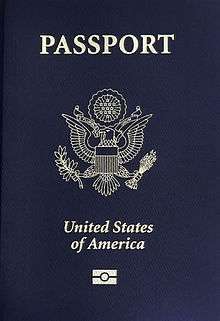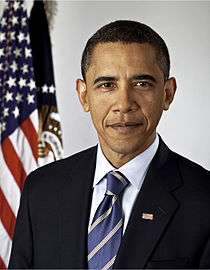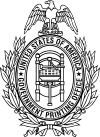United States Government Publishing Office
|
Official seal | |
|
Logo | |
| Agency overview | |
|---|---|
| Formed | March 4, 1861 |
| Jurisdiction | Federal government of the United States |
| Headquarters |
732 North Capitol St. NW Washington, D.C.[1] |
| Employees | 1,920[1] |
| Annual budget | US$126,200,000 (2012); approx. US$135 million (2011)[1] |
| Agency executive |
|
| Parent agency | United States Congress Joint Committee on Printing |
| Website | gpo.gov |
| Footnotes | |
| [1] | |
The United States Government Publishing Office (GPO) (formerly the Government Printing Office) is an agency of the legislative branch of the United States federal government. The office prints and binds documents produced by and for the federal government, including the Supreme Court, the Congress, the Executive Office of the President, executive departments, and independent agencies.
In December 2014 an omnibus spending bill funding US federal government operations was passed which included a provision changing the name from Government Printing Office to Government Publishing Office. Following signature by the President, the change took effect on December 17, 2014.[3]
History
GPO was created on June 23, 1860, by Congressional Joint Resolution 25. It began operations March 4, 1861, with 350 employees and reached a peak employment of 8,500 in 1972.[1] The agency began transformation to computer technology in 1980s; along with the gradual replacement of paper with electronic document distribution, this has led to a steady decline in the number of staff at the agency.[1] For its entire history, GPO has occupied the corner of North Capitol Street NW and H Street NW in the District of Columbia. The large red brick building that houses the GPO was erected in 1903 and is unusual in being one of the few large, red brick government structures in a city where most government buildings are mostly marble and granite. (The Smithsonian Castle and the Pension Building, now the National Building Museum, are other exceptions.) An additional structure was attached to its north in later years. The activities of GPO are defined in the public printing and documents chapters of Title 44 of the United States Code. The Public Printer, who serves as the head of GPO, is appointed by the President with the advice and consent of the Senate. The Public Printer selects a Superintendent of Documents.
The Superintendent of Documents (SuDocs) is in charge of the dissemination of information at the GPO. This is accomplished through the Federal Depository Library Program (FDLP), the Cataloging and Indexing Program and the Publication Sales Program, as well as operation of the Federal Citizen Information Center in Pueblo, Colorado. Adelaide Hasse was the founder of the Superintendent of Documents classification system.[4]
GPO first used 100 percent recycled paper for the Congressional Record and Federal Register from 1991-1997, under Public Printers Robert Houk and Michael DiMario. GPO resumed using recycled paper in 2009.
In March 2011, GPO issued a new illustrated official history covering the agency's 150 years of Keeping America Informed.[5]
With demand for print publications falling and a move underway to digital document production and preservation, the name of the GPO was officially changed to "Government Publishing Office" in a provision of an omnibus government funding bill passed by Congress in December 2014.[6] Following signature of this legislation by President Barack Obama, the name change took place on December 17, 2014.[3]
Public Printers of the United States
By law, the Public Printer heads the GPO. The position of Public Printer traces its roots back to Benjamin Franklin and the period before the American Revolution, when he served as "publick printer," whose job was to produce official government documents for Pennsylvania and other colonies.
Public Printers:
- Almon M. Clapp (1876–1877)
- John D. Defrees (1877–1882)
- Sterling P. Rounds (1882–1886)
- Thomas E. Benedict (1886–1889)
- Frank W. Palmer (1889–1894)
- Thomas E. Benedict (1894–1897)
- Frank W. Palmer (1897–1905), O.J. Ricketts (Acting, 1905–1905)
- Charles A. Stillings (1905–1908), William S. Rossiter (Acting, 1908–1908), Capt. Henry T. Brian (Acting, 1908–1908)
- John S. Leech (1908–1908)
- Samuel B. Donnelly (1908–1913)
- Cornelius Ford (1913–1921)
- George H. Carter (1921–1934)
- Augustus E. Giegengack (1934–1948), John J. Deviny (Acting, 1948–1948)
- John J. Deviny (1948–1953), Phillip L. Cole (Acting, 1953–1953)
- Raymond Blattenberger (1953–1961), John M. Wilson (Acting, 1961–1961), Felix E. Cristofane (Acting, 1961–1961)
- James L. Harrison (1961–1970)
- Adolphus N. Spence (1970–1972), Harry J. Humphrey (Acting, 1972–1973), L.T. Golden (Acting Deputy, 1973-1973)
- Thomas F. McCormick (1973–1977)
- John J. Boyle (1977–1980), Samuel Saylor (Acting, 1980–1981)
- Danford L. Sawyer, Jr. (1981–1984), William J. Barrett (Acting, 1984–1984)
- Ralph E. Kennickell, Jr. (1984–1988), Joseph E. Jenifer (Acting, 1988–1990)
- Robert Houk (1990–1993),[7] Michael F. DiMario (Acting, 1993–1993)
- Michael F. DiMario (1993[8]-2002)
- Bruce James (2002–2007),[9] William H. Turri (Acting, 2007–2007)
- Robert C. Tapella (2007–2010)[10]
- William J. Boarman (2010-2012)[11]
- Davita Vance-Cooks (2013– )[2]
Published government documents
Official journals of government
GPO contracts out much of the federal government's printing but prints the official journals of government in-house, including:
- Code of Federal Regulations
- Public and Private Laws
- The Congressional Record
- The Federal Register, which is the official daily publication for rules, proposed rules, and notices of Federal agencies and organizations.
- United States Code
- United States Statutes at Large
- House Journal and Senate Journal
Passports

GPO has been producing U.S. passports since the 1920s. The United States Department of State began issuing e-passports in 2006. The e-Passport includes an electronic chip embedded in the cover that contains the same information that is printed in the passport: name, date and place of birth, sex, dates of passport issuance and expiration, passport number, and photo of the bearer. GPO produces the blank e-Passport, while the Department of State receives and processes applications and issues individual passports.[12][13][14][15] GPO ceased production of legacy passports in May 2007, shifting production entirely to e-passports.
In March 2008, the Washington Times published a three-part story about the outsourcing of electronic passports to overseas companies, including one in Thailand that was subject to Chinese espionage.[13][16][17]
Trusted Traveler Program card
GPO designs, prints, encodes and personalizes Trusted Traveler Program cards (NEXUS, SENTRI and FAST) for the Department of Homeland Security, Customs and Border Protection (CBP).
GPO publications
 Official Presidential Photograph Official Presidential Photograph printed by GPO | |
|
|
- Cumulative Copyright Catalogs
- Medical and Surgical History of the War of the Rebellion (1870–88)
- Official Records of the American Civil War
- US Congressional Serial Set
- United States. Adjutant-General's Office. Military Information Division (1901). Publication, Issue 33. WASHINGTON: G.P.O. Retrieved February 19, 2011.(Document (United States. War Dept.))(Original from Harvard University)
- United States. Adjutant-General's Office. Military Information Division, p (1901). Publications, Issues 33-34. p. 528. Retrieved 1 April 2013.
- United States. Adjutant-General's Office. Military Information Division, Stephen L'H. Slocum, Carl Reichmann, Adna Romanga Chaffee (1901). Reports on military operations in South Africa and China. July, 1901. WASHINGTON: Govt. print. off. p. 600. Retrieved February 19, 2011.(Issue 33 of Publication (United States. Adjutant-General's Office. Military Information Division) Issue 143 of Document, United States War Dept Issue 33 of Publication, United States Adjutant-General's Office)
- Stephan L'H. Slocum, Carl Reichmann, Adna Romanza Chaffee, United States. Adjutant-General's Office. Military Information Division (1901). Reports on military operations in South Africa and China. WASHINGTON: G.P.O. p. 600. Retrieved February 19, 2011.(Issue 143 of Document (United States. War Dept.))(Original from the New York Public Library)
- United States. Bureau of Foreign Commerce, United States. Dept. of Commerce and Labor. Bureau of Statistics, United States. Bureau of Manufactures (1904). Commercial relations of the United States with foreign countries during the years ..., Volume 2. WASHINGTON: G.P.O. Retrieved June 28, 2010.(Original from Harvard University)
- United States. Bureau of Foreign Commerce (1891). Reports from the consuls of the United States, Issues 124–127. WASHINGTON: G.P.O. Retrieved July 17, 2011.(Original from the University of California)
- United States. War Dept (1899). Annual Reports of the War Department, Volume 1, Part 2; Volume 1, Part 4. U.S. Government Printing Office. Retrieved 24 April 2014.
- United States. Office of Education (1901). Report of the Federal Security Agency: Office of Education, Volume 2. U.S. Government Printing Office. Retrieved 24 April 2014.
- Philippines. Gobernador-General; Philippines. Governor (1919). Report of the Governor General of the Philippine Islands to the Secretary of War. U.S. Government Printing Office. Retrieved 24 April 2014.
- Chen, Da (1923). Chinese Migrations, with Special Reference to Labor Conditions. Volume 340 of Bulletin of the United States Bureau of Labor Statistics, Volume 85, Issue 19 of House Documents. U.S. Government Printing Office. Retrieved 24 April 2014.
GPO publishes the United States Style Manual.[19] Among the venerable series are Foreign Relations of the United States for the Department of State (since 1861), Statistical Abstract of the United States for the Census Bureau (since 1878), and Public Papers of the President, covering the administrations of Presidents Herbert Hoover onward (except Franklin D. Roosevelt, whose papers were privately printed).
GPO Police
Security for GPO facilities is provided by the Government Publishing Office Police.[20] The force is part of the GPO’s Physical Security Group and in 2003 had 53 officers.[21] Officers are appointed under Title 44 USC § 317 by the Public Printer (or his delegate). Their duty is to "protect persons and property in premises and adjacent areas occupied by or under the control of the Government Printing Office". Officers are authorized to bear and use arms in the performance of their duties, make arrests for violations of federal and state law, (and that of Washington, DC) and enforce the regulations of the Public Printer, including requiring the removal from GPO premises of individuals who violate such regulations. Officers have concurrent jurisdiction with the law enforcement agencies where the premises are located.[22] [23]
See also
- Bureau of Engraving and Printing is responsible for the printing of United States currency.
- Federal Digital System (FDsys)
- National Technical Information Service
- Queen's Printer
- United States Congress Joint Committee on Printing
References
- 1 2 3 4 5 6 Rein, Lisa (January 25, 2012), "U.S. printing office shrinks with round of buyouts", The Washington Post, washingtonpost.com, retrieved January 26, 2012
- 1 2 "Federal Eye". The Washington Post.
- 1 2 Government Publishing Office. "GPO IS NOW THE GOVERNMENT PUBLISHING OFFICE". gpo.gov. Retrieved 3 January 2015.
- ↑ GPO.gov
- ↑ GPO History
- ↑ Andrew Siddons, "Government Printer Renamed for Digital Age," New York Times, Dec. 12, 2014.
- ↑ Highbeam.com
- ↑ BUBL.ac.uk
- ↑ GPO.gov
- ↑ "Presidential Nominations Sent to the Senate, 4/19/10". Retrieved August 11, 2010.
- ↑ SacBee.com
- ↑ GPO's E-Passport Factsheet
- 1 2 Bill Gertz, GPO profits go to bonuses and trips, Washington Times, March 27, 2008
- ↑ Bill Gertz, Outsourced passport work scrutinized, Washington Times, March 26, 2008
- ↑ Confronting Digital Age Head-On, Washington Post, March 13, 2006
- ↑ Bill Gertz, Outsourced passports netting govt. profits, risking national security, Washington Times, March 26, 2008
- ↑ "GPO's backup plant on storm-prone Gulf". Washington Times. Retrieved January 18, 2010.
- ↑ "American Artifacts: Government Printing Office". C-SPAN. March 17, 2013. Retrieved March 17, 2013.
- ↑ "U.S. Government Printing Office Style Manual". United States Government Publishing Office. September 16, 2008. Retrieved July 30, 2015.
- ↑ "GPO Uniformed Police". Website of the Government Printing Office. Government Printing Office. Retrieved 18 April 2014.
- ↑ "Review of Potential Merger of the Library of Congress Police and/or the Government Printing Office Police with the U.S. Capitol Police". Government Accountability Office. 5 July 2002. Retrieved 5 July 2013.
- ↑ 44 U.S.C. § 317
- ↑ <http://www.gpo.gov/pdfs/careers/uniformed-police.pdf>
Further reading
- 100 GPO Years, 1861–1961: A History of United States Public Printing. Washington, DC: Government Printing Office, 2010.
External links
- GPO website
- United States House and Senate Committee Hearings and Publications in the LOUISiana Digital Library
- National Federation of Advanced Information Services
